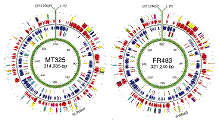Virology, Nebraska Center for
Date of this Version
2018
Citation
Front. Microbiol. 9:557.
Abstract
Characterizing the transmitted/founder (T/F) viruses of multi-variant SIV infection may shed new light on the understanding of mucosal transmission.We intrarectally inoculated six Chinese rhesus macaques with a single high dose of SIVmac251 (3.1 × 104 TCID50) and obtained 985 full-length env sequences from multiple tissues at 6 and 10 days post-infection by single genome amplification (SGA). All 6 monkeys were infected with a range of 2 to 8 T/F viruses and the dominant variants from the inoculum were still dominant in different tissues from each monkey. Interestingly, our data showed that a cluster of rare T/F viruses was unequally represented in different tissues. This cluster of rare T/F viruses phylogenetically related to the non-dominant SIV variants in the inoculum and was not detected in any rectum tissues, but could be identified in the descending colon, jejunum, spleen, or plasma. In 2 out of 6 macaques, identical SIVmac251 variants belonging to this cluster were detected simultaneously in descending colon/jejunum and the inoculum.We also demonstrated that the average CG dinucleotide frequency of these rare T/F viruses found in tissues, as well as non-dominant variants in the inoculum, was significantly higher than the dominant T/F viruses in tissues and the inoculum. Collectively, these findings suggest that descending colon/jejunum might be more susceptible than rectum to SIV in the very early phase of infection. And host CG suppression, which was previously shown to inhibit HIV replication in vitro, may also contribute to the bottleneck selection during in vivo transmission.
Included in
Biological Phenomena, Cell Phenomena, and Immunity Commons, Cell and Developmental Biology Commons, Genetics and Genomics Commons, Infectious Disease Commons, Medical Immunology Commons, Medical Pathology Commons, Virology Commons


Comments
Chen J, Ren Y, Daharsh L, Liu L, Kang G, Li Q, Wei Q, Wan Y and Xu J (2018)
Open access
doi: 10.3389/fmicb.2018.00557